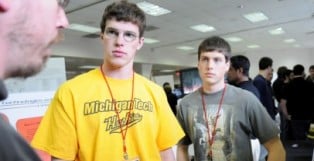MS Defense: Nolan Gamet, GMES
M.S. in Geology candidate Nolan Gamet will present a final oral defense on Thursday (June 22) from 10 a.m. to noon in Dow 610.
Virtual attendance is also invited via Zoom.
Gamet is advised by James DeGraff, with Chad Deering, William Rose and Jeremy Shannon as committee members.
Gamet's defense is titled "Structural Analysis and Interpretation of the Deformation Along the Keweenaw Fault System from Lake Linden to Mohawk, Michigan."
From the abstract:
The Keweenaw fault is likely the most significant fault associated with the Midcontinent Rift System, with an estimated reverse slip of ~10 km that places Portage Lake Volcanics (~1.1 Ga) over much younger Jacobsville Sandstone (~1.0 Ga). Published bedrock geology maps with cross sections from the 1950s show the fault as a single continuous trace that is locally associated with smaller cross faults and splays. This M.S. thesis presents a structural analysis and interpretation of the Keweenaw fault system between Lake Linden and Mohawk, MI, which includes data collected from well-known localities such as Houghton-Douglass Falls, the St. Louis ravine, the Natural Wall ravine, and the anomalous rhyolite body near Copper City. These data were used to revise existing bedrock geology maps, construct new cross-sections, and analyze fold geometry and fault slip behavior to infer aspects of the tectonic regime that caused the deformation.
New field mapping has refined the trace geometry of the Keweenaw fault (KF) and smaller associated faults by shifting the main fault’s position laterally as much as 150m, revising intersections between several splay faults and the main fault, and suggesting the existence of several footwall splays not previously recognized. Orientation analysis of Jacobsville Sandstone strata in the footwall of the fault system defines fold axes with plunge directions changing from southwest in the south to northeast in the north. The style of folding also changes along the fault from broad syncline-anticline pairs in the southwest to tightly folded anticlines with overturned bedding to the northeast. Fault-slip analyses reveal a bimodal distribution strike-slip and reverse slip along the fault system that collectively define a 1:1 ratio and a nearly north-south maximum tectonic shortening direction of 2°-182°. The NS-trending shortening direction computed from fault-slip analysis creates a paradox yet to be explained. However, fold axis trends in the current area indicate shortening along an ESE-trending line, which is consistent with recent results for the fault system northeast of this study area and with Grenville orogenic compression being the primary cause of slip along the Keweenaw fault system.
All are welcome to attend.

